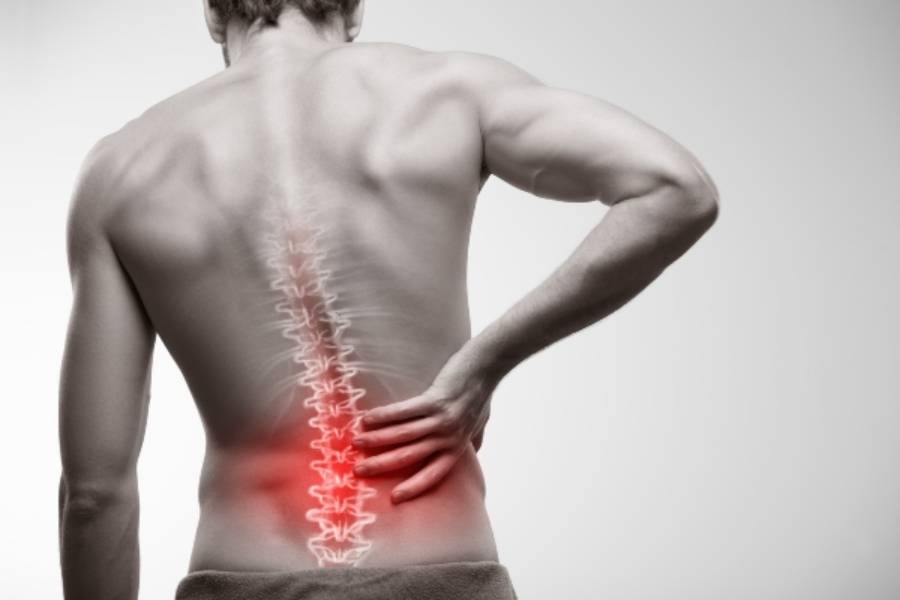Your spine consists of a series of bones (vertebrae) stacked on top of each other. The top-down column includes seven bones in the cervical spine, 12 in the thoracic spine and five in the lumbar spine, followed by the sacrum and coccyx at the base. These bones are preceded by discs. The discs protect the bones by absorbing shocks from everyday activities such as walking, lifting and turning.
Each disc has two parts: a soft, gelatin inner part and a hard outer ring. Injury or weakness can cause the inside of the disc to slide out of the outer ring. This is known as a slipped, protruding, or protruding disc. It causes pain and discomfort. If the sliding disc pushes on one of your spinal nerves, you may also feel numbness and pain in the affected nerve.

What are the symptoms of a slipped disc?
You may have a herniated disc on either side of your spine, from your neck to your back. The lower back is one of the most common areas for herniated discs. A herniated disc can put more pressure on the nerves and surrounding muscles.
Symptoms of a herniated disc include:
- pain and suffering, often on one side of the body
- pain spreading to arms or legs
- the pain worsens at night or in some movements
- the pain worsens when standing or sitting
- pain when walking short
- muscle weakness unexplained
- tingling, pain, or burning sensation in the affected area
Risk factors:
Factors that may increase the chances of a herniated disc include:
- Weight: Obesity puts additional pressure on the disc in the back.
- Work: People with demanding physical activity have a high risk of back problems. Frequent lifting, pulling, twisting, twisting, and twisting can also increase the chances of a herniated disc.
- Genetics: Some people inherit predisposition to develop a herniated disc.
- Smoking: Smoking is thought to reduce the oxygen content in the discs, causing them to break down faster.
- Frequent driving: Prolonged sitting in conjunction with motor vehicle exercise can put pressure on the spine.
- Being sedentary: Regular exercise can help prevent a herniated disc.
Diagnosis:
During the physical exam, your doctor will check to see if your back is soft. You may be told to lie down and move your feet to different positions to help determine the cause of your pain.
- X-Rays: Flat X-rays do not detect herniated discs, but they can remove other causes of back pain, such as pain, sores, back problems, or broken bones.
- CT Scan: CT scans take x-rays from different parts and combine them to make an image of the spine and its surrounding organs.
- MRI: Images of the inner part are made using radio waves and solid magnetic fields. This test can be used to confirm the location of the herniated disc and to determine which nerves are affected.
- Myelogram: A dye is injected into the spinal fluid before a CT scan is taken. This test can show pressure on the spinal cord or nerves due to multiple herniated disks or other conditions.
How are slipped discs treated?
Treatment for herniated disc ranges from conservative to surgical. Treatment usually depends on the level of discomfort you have and the length of the disc.
Most people can transmit a herniated disc by using an exercise program that stretches and strengthens the back and surrounding muscles. A physical therapist may recommend exercise that can strengthen your back and reduce your pain.
Taking painkillers to avoid high blood pressure can also help. If your disc pain does not accept the above-mentioned treatments, your doctor may prescribe stronger medications. These include:
- a physical stimulant to reduce muscle spasms
- drugs reduce pain
- nerve pain medications such as gabapentin or duloxetine
How to prevent a slipped disc?
It may not be possible to prevent a slipped disc, but you can take steps to reduce your risk of developing a slipped disc. These steps include:
- Use safe lifting techniques: Bend and lift from your knees, not your waist.
- Maintain a healthy weight.
- Do not remain seated for long periods; get up and stretch periodically.
- Do exercises to strengthen the muscles in your back, legs, and abdomen.
Why to choose Dr. Prasad Umbarkar for Slipped Disc Treatment?
Dr. Prasad Umbarkar is one of the best Brain and Spine Specialists in Sangamner, Ahmednagar with vast clinical and surgical experience. He has operated on more than 3000+ patients with Brain and spine-related disorders. Please feel free to call us on 8669177494 or click on Book An Appointment for your best treatment.
